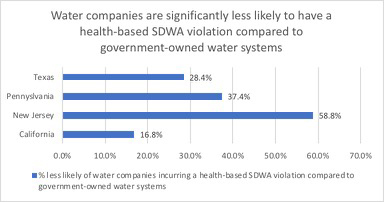WASHINGTON--(BUSINESS WIRE)--An expanded analysis of the largest and most comprehensive study conducted on Safe Drinking Water Act (SDWA) compliance shows that community water systems owned by regulated water companies are significantly less likely to violate the SDWA than water systems owned and run by local governments.
The original study, published in the Proceedings of the National Academy of Sciences in February 2018, reviewed Environmental Protection Agency (EPA) data from 1982 to 2015 and found that private ownership of a water system was “significantly associated with higher compliance.” The dataset included the compliance records of 17,900 community water systems from across the continental United States.
“Flint provides an unfortunate example of how a government-run system was unable to ensure the delivery of safe water to its citizens. As a former state utility regulator, I have seen firsthand the harsh realities of what happens when communities are unable to properly manage their water systems, jeopardizing public health and safety,” said Robert Powelson, CEO and president of the National Association of Water Companies (NAWC). “The results of this study further confirm that regulated water companies nationwide are doing a better job than their municipal counterparts in delivering the highest quality water possible.”
A further analysis of the dataset was conducted by Dr. Justin Adams of Encina Advisors, an economics research and statistical analysis consultancy based in California. The finding that water companies have higher rates of SDWA compliance was evident both nationally and in each of the four states analyzed: California, Texas, Pennsylvania, and New Jersey. This marks the first time a state-level analysis comparing drinking water compliance records of regulated water companies and local governments has been conducted using this dataset.
“We wanted see how the ownership of water systems impacted drinking water compliance rates in different states,” said Dr. Adams. “The data show very clearly that water systems owned by regulated companies strongly outperform water systems owned and run by local governments on Safe Drinking Water Act compliance.”
“Local governments across America face urgent water system infrastructure and operations challenges. That is, no doubt, one of the key contributors to what we see in this study as some small and midsized municipalities struggle to provide safe water to residents,” said Powelson. “NAWC member companies are well-positioned to bring the expertise and investment troubled systems need to ensure Americans can count on safe and reliable water service.”
The initial study published in the Proceedings of the National Academy of Sciences was authored by Dr. Maura Allaire, University of California Irvine; Haowei Wu, Columbia University; and Dr. Upmanu Lall, Columbia University. The state-level analysis of EPA data conducted by Encina Advisors was funded by the National Association of Water Companies.
The National Association of Water Companies (NAWC) represents regulated water and wastewater companies, as well as ones engaging in partnerships with municipal utilities. NAWC members provide 73 million Americans with safe and reliable water service every day and have an exceptional record of compliance with federal and state health and environmental regulations. Ensuring this high standard of quality requires extraordinary amounts of capital investment. NAWC estimates that its six largest members alone are collectively investing $2.7 billion each year in their water and wastewater systems. For more information about NAWC, please visit NAWC.org or follow on Twitter, Facebook and YouTube.

